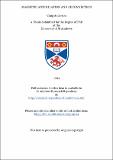Files in this item
Magnetic annihilation and reconnection
Item metadata
| dc.contributor.advisor | Priest, E. R. (Eric Ronald) | |
| dc.contributor.author | Anderson, Craig | |
| dc.coverage.spatial | 104 p. | en_US |
| dc.date.accessioned | 2018-06-13T13:52:04Z | |
| dc.date.available | 2018-06-13T13:52:04Z | |
| dc.date.issued | 1994 | |
| dc.identifier.uri | https://hdl.handle.net/10023/14014 | |
| dc.description.abstract | This thesis presents several analytical models of magnetic annihilation and reconnection and studies their properties. The models investigated are 1. Steady-state magnetic annihilation. The assumption of straight field lines reduces the resistive, viscous MHD equations to two ordinary differential equations, one for the flow and one for the magnetic field. These equations can be solved exactly (for the case of a simple stagnation-point flow) and asymptotically (for a more general stagnation-point flow). In both cases the reconnection rates can be fast due to advection effects which create large magnetic gradients. 2. Time-dependent magnetic annihilation. The assumption of straight field lines whose strength can vary with time reduces the MHD equations to two partial differential equations, one for the flow and one for the magnetic field. The time-modulated simple stagnation-point flow is shown to be an exact solution and the equation for the magnetic field is then solved on infinite and finite intervals. For the infinite interval the reconnection rates are shown to be dependent on the nature of the advected initial field. Also examined are self-similar solutions and the effect of variation of diffusivity with time. 3. Annihilation in a compressible, inviscid plasma. Here, the assumption of straight field lines and an inviscid, compressible flow reduce the MHD equations to a pair of non-linear coupled partial differential equations. Further assuming that the density only varies in one direction and the flow is of a stagnation-point type allow these equations to be solved approximately analytically and exactly numerically. It is shown that the magnetic field and reconnection rates are the same in both the compressible and incompressible cases and that the density of the plasma is greatest within the current sheet. 4. Steady-state magnetic reconnection. For an incompressible flow the MHD equations can be reduced to two coupled non-linear partial differential equations. These two equations are studied by seeking asymptotic solutions around the annihilation solution and then looking for series solutions to the first-order equations. It is found that the magnetic field always has a magnetic cusp and never possesses an x-type neutral point. 5. Reconnection in a viscous plasma. Assuming that the viscous forces dominate, the induction equation and equation of motion decouple and become linear. The magnetic field is obtained for the case of a simple stagnation-point flow. It is shown that if the inflow magnetic field is taken to be straight then the magnetic field within the region tends towards the annihilation solution as the magnetic Reynolds number increases. 6. Magnetic flipping. A previous ideal model of magnetic flipping is refined so that it becomes an exact solution of the MHD equations. In the refined model the streamlines are straight rather than curved. Assuming straight streamlines, the MHD equations reduce to two linear ordinary differential equations, one for the flow and one for the magnetic field. These are then solved exactly analytically to find a flow containing a viscous boundary layer and a magnetic field that contains an x-type neutral point. The angle between the separatrices of the field is determined by the Reynolds and magnetic Reynolds numbers. It is shown that most of the ohmic heating occurs within the viscous boundary layer. | en_US |
| dc.language.iso | en | en_US |
| dc.publisher | University of St Andrews | en |
| dc.subject.lcc | QA927.A7 | |
| dc.subject.lcsh | Wave-motion, Theory of | en |
| dc.title | Magnetic annihilation and reconnection | en_US |
| dc.type | Thesis | en_US |
| dc.contributor.sponsor | Science and Engineering Research Council (SERC) | en_US |
| dc.type.qualificationlevel | Doctoral | en_US |
| dc.type.qualificationname | PhD Doctor of Philosophy | en_US |
| dc.publisher.institution | The University of St Andrews | en_US |
This item appears in the following Collection(s)
Items in the St Andrews Research Repository are protected by copyright, with all rights reserved, unless otherwise indicated.

